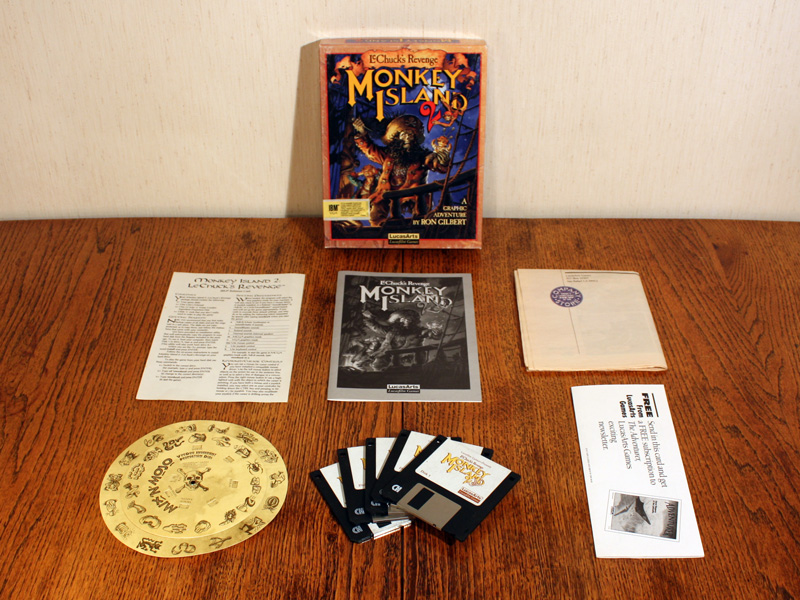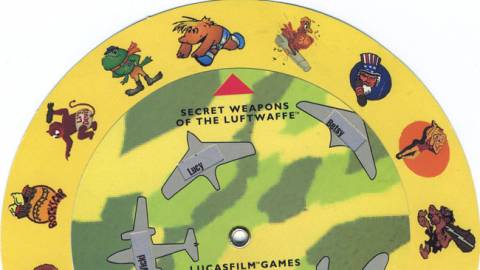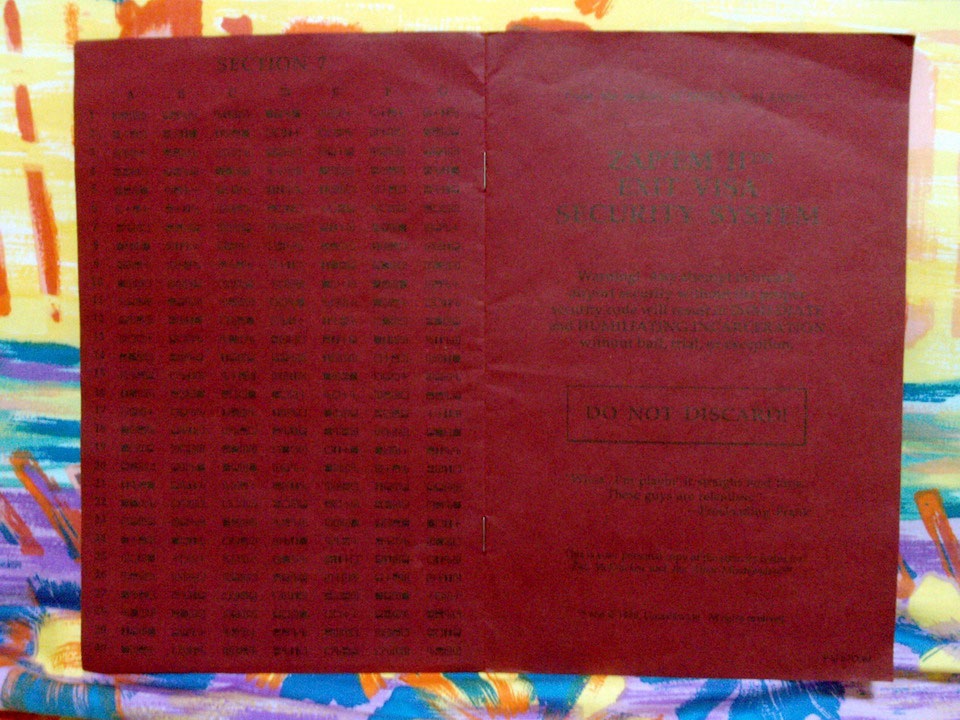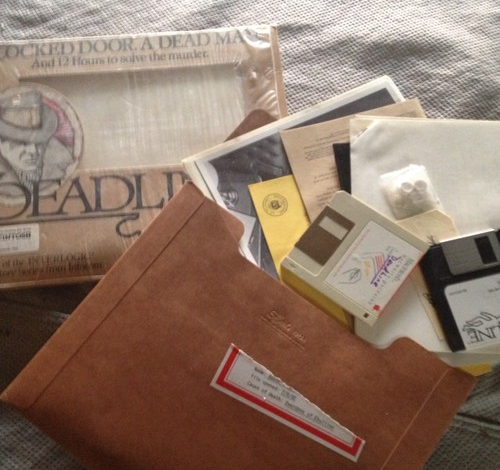Rare protection schemes against copying games and software - what were they?
In many cases, the methods used in the 1980s of the last century were more effective than modern ones.

Source: tvtropes.org
Now, no matter what you are listening to, watching, whatever you play - 90% of all content is protected by copyright. Developers build in their products a variety of "anti-piracy" protection schemes. Software requires licenses, codes, user authentication in the network. It is clear that all these technologies of protection against "pirates" did not appear just like that. For many years they have developed and improved. What was the source?
Software developers, including games, have used copy protection since the days when the Internet was not available. In most cases, the protective circuits were not digital at all, but ... analog.
 Early copy protection schemes were of two types: code disks and manual search. If it was easy to copy a game or some kind of software, then it was difficult, if not impossible, to overcome a similar method of protection. The moving elements, the colored pages, the “question-answer” cycle — all this was quite effective, although it annoyed some users. And then the Internet has not yet become a worldwide network. No digital scans, color copiers, bruteforce and others either did not exist, or it was all inaccessible to the ordinary user. About analog protection methods can be described as low technologies, which helped to solve high-tech problems.
Early copy protection schemes were of two types: code disks and manual search. If it was easy to copy a game or some kind of software, then it was difficult, if not impossible, to overcome a similar method of protection. The moving elements, the colored pages, the “question-answer” cycle — all this was quite effective, although it annoyed some users. And then the Internet has not yet become a worldwide network. No digital scans, color copiers, bruteforce and others either did not exist, or it was all inaccessible to the ordinary user. About analog protection methods can be described as low technologies, which helped to solve high-tech problems.')
Code Wheels
Many games were delivered with special mechanical devices, which were called “code disks”. The game “Zany Golf”, for example, was sold along with two cardboard discs, where one circle was slightly smaller than the other. On the edges of the discs were applied certain words. There were also spiral slots on the smaller disk. At a certain point in the game, the user was informed of the word from the outer side of the larger disk, the word from the outer side of the smaller disk, and the slot code into which it was necessary to look.

If the player placed both discs correctly, then a code appeared in the slot, which had to be entered in the game to continue. In the game “Zany Golf” terms were put on the discs. The developers of the game “Their Finest Hour” did the same. They used the names of aircraft Luftwaffe.

And the game developers SSI complicated the lives of buyers. Instead of ordinary words, they took characters from the languages of fantasy races. Plus, there were three sets of cuts on the disk, each set was located strictly in its spiral. Such disks were extremely difficult to copy manually. And if you photograph or use a copier, you had to spoil the whole structure. Well, what self-respecting geek will destroy the software documentation? Of course, the discs were copied, but these were rather isolated cases.

A similar system was used in Alone in the Dark 2. There were not just cardboard discs, but something like game cards with a number of geometric elements on one side. These cards were associated with the plot of the game, without them pass Alone in the Dark 2 was impossible. At a certain point in the game, the gamer was informed of a pair of map values, and the slot number where it was necessary to look, superimposing one card on another. For example, “put the“ 3 of Diamonds ”card on“ Queen of Spades ”and name the symbol in the first row of the second column. Almost all of the game elements were colored, making it impossible to use a copier, which was black and white at the time. This game of "saving" was almost impossible.
Manual search
This is the usual protection for a large number of games, including Populous, X-Com: UFO Defense, Railroad Tycoon, Prophecy, and many other names. In this case, no additional items were sold with the game. The information needed for verification with the game was contained in the instructions for the game. The necessary data could be printed on the free pages of the instruction. In the game Populous, the user was shown the coat of arms of a certain world and asked to name this world. In the instructions, the coats of arms with the indicated names were printed at the bottom of a row of pages. So it was necessary, at times, to scroll through all the instructions for finding the required data. And without the manual it was impossible to play.

Railroad Tycoon showed images of trains, and you had to name them. In Prophecy, the image of the enemy was shown, and it was necessary to identify this character. This method of copy protection forced the user to flip through his instructions all the time, so that with an active game, the manuals became quite battered after a short time. The pauses in the game, when it was necessary to pass the test, were very annoying, plus time was wasted.
In Sim City, a special booklet with red pages was used, which was put into the box with the game. This booklet had 4 pages and 88 different codes. All this was very difficult to read, even in bright sunlight. The developers thus tried to protect their booklet from a copier. And they did it - it was possible to “open the document”, but the output was an almost black sheet, where it was impossible to understand anything. How many players have spoiled their eyesight is unknown. Time to work with the booklet also took a decent amount.

Less time was spent working with X-Com: UFO Defense. Here, gamers were told what to do and where to look. Usually it was necessary to type the code located on the page that the game called. The developers of other games went further, and as a result, the user needed to find a specific line of text on a given page and name a certain word on the account. Not very creative, but it did not take too much time either.
Chart Confirmation
This method of copy protection used by the developers of the game "Ultima". A very colorful and detailed map was put into the box. To confirm the original game, the user had to look for the answer both in the manual and on the map, at the intersection of a certain longitude and latitude. In the order of things there were questions like “How long is the city of Skara Brae?”. And if we also take into account the fact that all the information on the card was recorded using runes, then the newcomer had to have difficulty - you had to translate everything first (using the manual), and then look for longitude. But it was more like entertainment, so gamers didn't really complain.

Even more interesting was the combination of digital and real elements of the game “Deadline” from Infocom. The developers could not fit all the game texts to 80 KB. And then it was decided to create not digital, but real game elements with the necessary texts. Their original image combined with the digital world. It was both copy protection and a very exciting game, which was appreciated by both critics and gamers.

The original scheme was involved and the developers of the game "Indianopolis 500: The Simulation". During the virtual races, the player was shown a pixelated portrait of one of the winners of the real Indy 500 races. With the game delivered an almanac indicating all the race winners for all years. The player was required to specify the name of the person he saw on the display screen. Or a gamer was asked to write a model of the car that the driver was driving.
And there was the game "Where in the World is Carmen San Diego?", In the box with which a copy of "1990 World Almanac" was put. The buyer of the game had to answer questions like “What is the population in Zambia?”. It was both a defense and at the same time an educational tool.
 An interesting way to protect against copying was used by the developers of the first versions of the Game Guru software supplied on diskettes. Already at that time, this program allowed editing these games in a hex editor that was included in the software package. The program told what needs to be changed and where, in order to get infinite lives in different games, a lot of money, etc.
An interesting way to protect against copying was used by the developers of the first versions of the Game Guru software supplied on diskettes. Already at that time, this program allowed editing these games in a hex editor that was included in the software package. The program told what needs to be changed and where, in order to get infinite lives in different games, a lot of money, etc.So, the number of program installations was limited to three installations. Every time a software was installed, a marker was added to the special file on the disk. As soon as the number of markers reached three, the program could no longer be installed. If the owner of the diskette tried to protect it from writing, the software simply stopped working and did not start.
And here is another one of the methods of protection - an appeal to the buyer, to his consciousness.
At the time when this video appeared (it was shown on TV), PC users learned how to work with boot disks and extended memory, and often copied games and programs from each other. I wonder how many computer users, after viewing this video, refused to illegally copy the coveted game, taken from a friend?
Source: https://habr.com/ru/post/396543/
All Articles